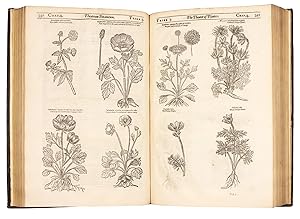Descripción
Illustrated with an additional, pictorial title page engraved by William Marshall (fl. 1617-1650) and 2716 woodcuts of plants. Bound in fine late seventeenth-century black morocco, paneled gilt, with a central lozenge featuring acorns and large scrolling tools at the corners, spine gilt in compartments, gilt red morocco labels, endcaps neatly restored, the leather along the hinges worn. Complete with the terminal errata leaf; bifolium 4C3-4 apparently supplied to rectify a binding error in which lvs. 4C2 and 4C5 were bound in twice (manuscript note to that effect); eighteenth- or early 19th century ownership inscription to each volume of "R. James", with scattered annotations in his hand throughout (adding Latin names and some cross-references). Clean marginal tears (no loss) to lvs. F4, Ttt5, and 5G6; clean tear in text (no loss) to leaf Vvv5. A handful of leaves lightly toned; occ. rust spots (with one tiny hole on leaf Nn4 and another on leaf Nnnn6; slightly larger rust holes on 6R4-6, one on each leaf). Nnnn5, Vvvv5-6 marginal dampstain. Second volume with some light toning and some shine-through from the woodcuts. The gardener and apothecary John Parkinson (1567-1650) received the title of Royal Apothecary from King James I. Later, Charles I appointed him as his chief botanist. "Throughout his long working life, John Parkinson earned his living and reputation as an apothecary, preparing and dispensing plant-based and other medicines from his shop on Ludgate Hill, as well as growing and cultivating the plants that were the essential tools of his trade on a substantial plot in Long Acre near Covent Garden, further outside the London city walls to the west."(Jill Francis, John Parkinson: Gardener and Apothecary of London, p. 229) "Parkinson s Theatrum was the largest herbal in English to date; it was also the last great medicinally-based plant study, by an author who thought of himself as first and foremost an apothecary. Altogether 2,716 woodblocks were individually cut for this massive herbal, which describes more than 4,000 plants, most of them with medicinal properties. Parkinson had given notice of his intention to compile an herbal in his 'Paradisi in sole Paradisus terrestris' of 1629, but was delayed by the publication of the second Johnson edition of 'Gerard's Herball' in 1636. This delay meant that Parkinson's work had time to grow much larger than originally planned, and on publication it included about 1,000 more plants than Gerard s, and describes many species not previously recorded."(Tomasi, Oak Spring Flora, p. 160) "[The herbal] was a monumental work drawing on Parkinson's 50 years of experience of growing and working with plants. Although working within a traditional genre, Parkinson's great herbal was firmly rooted in the new empirical methods of scientific observation and experiment… "According to Parkinson, [earlier writers of herbals, such as William Turner] presumed a knowledge of the new plants arriving from overseas - often as little more than seeds, roots or dried specimens -but they cannot possibly have understood or seen for themselves the nature of the plant. As he writes elsewhere, 'some of these errors are ancient, and continued by long tradition, and others are of later invention, and therefore more to be condemned'. Parkinson, on the other hand, actually took the seeds, bulbs and roots and planted them in his own garden in Long Acre to observe how they grew and what they looked like. Some he received via fellow gardeners: for instance, his friend John Tradescant sent him a root of Indian Moly to plant in his garden. On another occasion, in 1608, Parkinson commissioned the plant hunter William Boel to seek out for him new species of plants while travelling in Spain and he returned with over 200 different kinds of seeds. Parkinson wrote that 'by sowing them [I] saw the faces of a great many excellent plants'. It was in this way, by careful scientific method, that he built up his extensive kno. N° de ref. del artículo 5018
Contactar al vendedor
Denunciar este artículo
![]()




